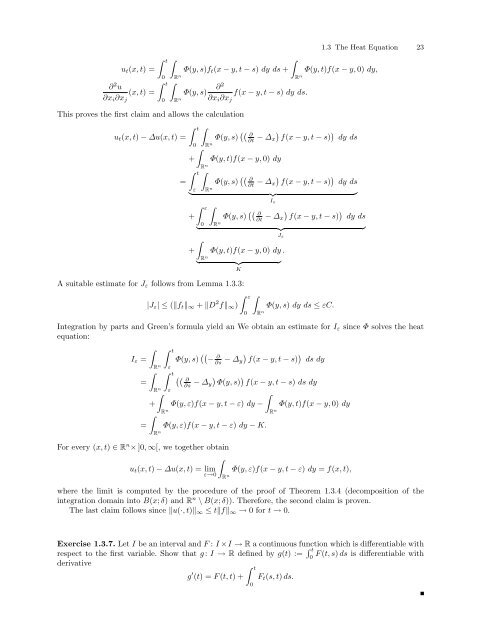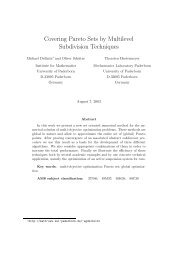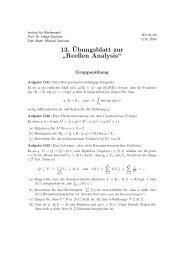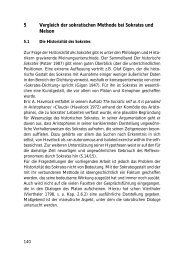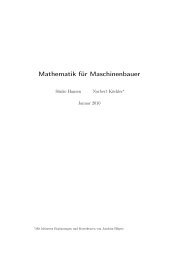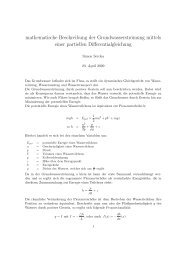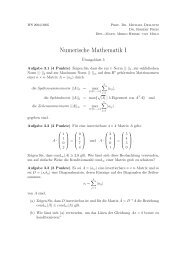Partial Differential Equations
Partial Differential Equations
Partial Differential Equations
You also want an ePaper? Increase the reach of your titles
YUMPU automatically turns print PDFs into web optimized ePapers that Google loves.
u t (x, t) =<br />
∂ 2 u<br />
∂x i ∂x j<br />
(x, t) =<br />
∫ t<br />
0<br />
∫ t<br />
This proves the first claim and allows the calculation<br />
0<br />
1.3 The Heat Equation 23<br />
∫<br />
∫<br />
Φ(y, s)f t (x − y, t − s) dy ds + Φ(y, t)f(x − y, 0) dy,<br />
R n R<br />
∫<br />
n ∂ 2<br />
Φ(y, s) f(x − y, t − s) dy ds.<br />
R ∂x n i ∂x j<br />
∫ t ∫<br />
u t (x, t) − ∆u(x, t) = Φ(y, s) (( ∂<br />
∂t − ∆ )<br />
x)<br />
f(x − y, t − s) dy ds<br />
0 R<br />
∫<br />
n<br />
+ Φ(y, t)f(x − y, 0) dy<br />
R<br />
∫ n t ∫<br />
= Φ(y, s) (( ∂<br />
∂t − ∆ )<br />
x)<br />
f(x − y, t − s) dy ds<br />
ε R<br />
} n {{ }<br />
I ε<br />
∫ ε ∫<br />
+ Φ(y, s) (( ∂<br />
∂t − ∆ )<br />
x)<br />
f(x − y, t − s) dy ds<br />
0 R<br />
} n {{ }<br />
J ε<br />
∫<br />
+ Φ(y, t)f(x − y, 0) dy .<br />
R<br />
} n {{ }<br />
K<br />
A suitable estimate for J ε follows from Lemma 1.3.3:<br />
|J ε | ≤ (‖f t ‖ ∞ + ‖D 2 f‖ ∞ )<br />
∫ ε<br />
0<br />
∫<br />
R n Φ(y, s) dy ds ≤ εC.<br />
Integration by parts and Green’s formula yield an We obtain an estimate for I ε since Φ solves the heat<br />
equation:<br />
I ε =<br />
=<br />
=<br />
∫R n ∫ t<br />
ε<br />
∫ t ∫R n<br />
ε<br />
Φ(y, s) (( − ∂ ∂s − ∆ y)<br />
f(x − y, t − s)<br />
)<br />
ds dy<br />
(( ∂<br />
∂s − ∆ ) )<br />
y Φ(y, s) f(x − y, t − s) ds dy<br />
∫<br />
∫<br />
+ Φ(y, ε)f(x − y, t − ε) dy −<br />
R<br />
∫<br />
n Φ(y, ε)f(x − y, t − ε) dy − K.<br />
R n<br />
For every (x, t) ∈ R n × ]0, ∞[, we together obtain<br />
R n Φ(y, t)f(x − y, 0) dy<br />
∫<br />
u t (x, t) − ∆u(x, t) = lim Φ(y, ε)f(x − y, t − ε) dy = f(x, t),<br />
ε→0<br />
R n<br />
where the limit is computed by the procedure of the proof of Theorem 1.3.4 (decomposition of the<br />
integration domain into B(x; δ) and R n \ B(x; δ)). Therefore, the second claim is proven.<br />
The last claim follows since ‖u(·, t)‖ ∞ ≤ t‖f‖ ∞ → 0 for t → 0.<br />
Exercise 1.3.7. Let I be an interval and F : I ×I → R a continuous function which is differentiable with<br />
respect to the first variable. Show that g : I → R defined by g(t) := ∫ t<br />
F (t, s) ds is differentiable with<br />
0<br />
derivative<br />
g ′ (t) = F (t, t) +<br />
∫ t<br />
0<br />
F t (s, t) ds.


